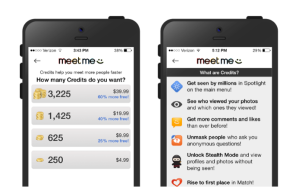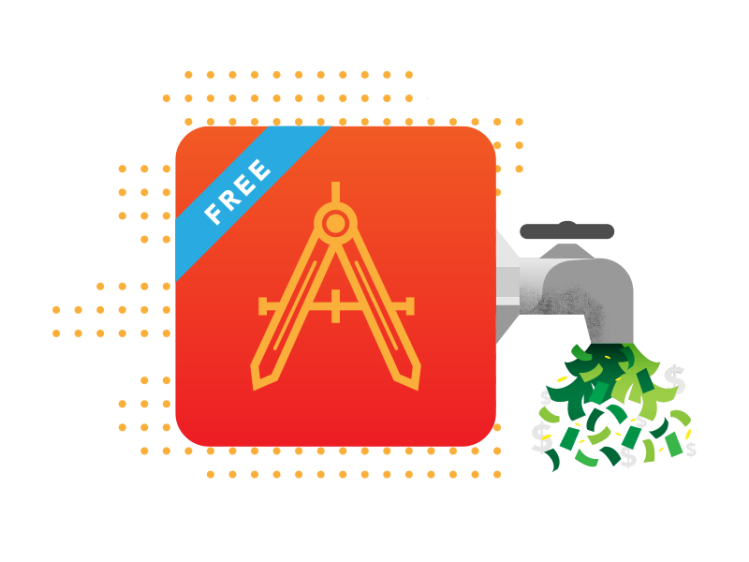This sponsored post is produced by Localytics.
There are over a million apps currently in the App Store, and an overwhelming majority of them are free. What does this mean for your app monetization plan? Going after revenue with a paid app can be a risky endeavor — you’re betting that users will be willing to fork over money when there are so many free alternatives.
With a free app you’re likely to get more installs, but then you have to be smart about monetizing. And in many ways, monetization models for free apps are superior to paid apps, allowing more room for creativity and the possibility of improving the app experience (and making it easier for users to make purchases).
In this post, we highlight four of the models you can use to drive app revenue, and help you discern which model best suits your app.
1. In-App Advertising
Mobile ads are appearing more and more in apps because they allow you to monetize without asking for money directly from users. With in-app advertising, you remove the cost-barrier to purchasing your app and allow free downloads. Your goal is to create a large (and stable) user base and gather relevant information about those users to sell to other brands and app publishers, who pay you to place targeted ads in your app. And, because your app is completely free, you have a better chance of gaining (and retaining) new users.
When done correctly, ads are a smart choice, because they don’t distract from the user experience. In-app advertising is done in a highly-targeted, personalized way to attract users to relevant offers — they turn bad when they cross the line by creating privacy concerns. This model requires care and attention to ensure that it doesn’t overrun your native app value and dissuade otherwise engaged users.
This model might be right for you if:
- There are no organic opportunities for in-app purchases in your app
- You regularly collect preference data about users
- Ads won’t take away from your app UX (or take up too much screen space)
- You want to be part of a lucrative and growing ad industry
2. Freemium (Gated Features)
As with the in-app advertising model, a freemium app is also offered for free. However, certain “advanced” or “premium” features are gated and cost money to be unlocked. In other words, people have access to your app’s basic functionality and features, but there is a charge to then access everything. The goal is to accumulate and engage app users until they see the value of the app and are willing to pay to access additional in-app tools.
Many successful gaming apps fall into this category— they have found success by making basic game versions free to all users, but requiring the user to purchase additional levels or premium options. From Angry Birds to the shockingly successful Kim Kardashian: Hollywood game, freemium apps allow people to easily play and become fans without hesitating at the initial price. Once app users have conquered a few levels or want to up their status, they’re engaged enough to pay for the full-fledged version for more hours of fun.
One note of caution: be upfront in your App Store listing and other appropriate places that your app requires purchases to unlock advanced features, levels or other features. If users don’t realize that’s what’s in store, it could turn them off permanently.
This model might be right for you if:
- You’re a gaming app
- You have levels or advanced features already in your app
- You have long session lengths and highly-engaged users
- Can provide a great free app experience (and don’t just save the good stuff for paying users)
3. In-App Purchases
In-app purchases are exactly what they sound like.The goal of this model is to turn your app into another sales channel (for physical products that are used in the real world) or a mobile storefront (for virtual goods which can only be used inside the app) and retain the profits. In-app purchases can include a wide variety of consumer goods, and aren’t limited to retail apps.
This model can help you make comfortable profits with the lowest amount of risk, plus, buying virtual goods can lead to deeper levels of engagement (growing monetization strategy).
make comfortable profits with the lowest amount of risk, plus, buying virtual goods can lead to deeper levels of engagement (growing monetization strategy).
One way to utilize this model is to sell virtual goods such as extra lives or in-game currency. Dating apps, such as MeetMe, allow you to freely browse profiles and chat with other users, but also offer credits to enhance your visibility and gain new ways to interact with people. MeetMe’s purchase model is lucrative because the app is able to clearly highlight the benefits of in-app currency. Your takeaway: whatever your app is selling, make sure the in-app purchases feel like a natural part of the app experience (and have an easy checkout process). Also, make sure you clearly and resolutely market that your app has in-app purchases, to keep things honest.
This model might be right for you if:
- You’re a retail or services app
- You provide goods with clearly-defined value
- You have a clear opportunity to introduce goods into your app (such as Keep, an app that allows you to “keep,” or add items of interest to your various boards, and recently integrated a shopping cart feature)
- You don’t mind that App Stores usually take a cut of the revenue for virtual goods (but not physical goods or services) purchased inside your app
![]()
Get the Localytics case study showing how one app publisher increased session length and in-app purchases by 35%!
4. Sponsorships (Incentivized Advertising)
Sponsorships are easily the newest (and greenest) monetization model. With sponsorships, you partner with advertisers who provide your users with rewards when they complete certain actions within your app. In this model, your app earns money by taking a share of the revenue from redeemed rewards, and simultaneously allows you to incorporate advertising that actually enhances your app’s ability to engage users. This model can be adapted for almost any vertical, and can be better received by app users because it is relevant and related to an app’s purpose.
An early adopter of this app business model is RunKeeper. RunKeeper motivates users to track their running activity in-app by offering “rewards” upon completion. These exclusive rewards and promotions come from advertisers, hence, incentivized advertising. The user feels rewarded for having used the app, and the advertiser gains impressions, click throughs and conversions. Using this strategy, RunKeeper can monetize their app without disrupting the user experience with potentially intrusive banner ads.
This model might be right for you if:
- You prefer a behind-the-scenes (and rewards-driven) monetization plan
- You have an app that makes it easy to reward in-app activity
- You want to try something new and different (and don’t mind taking a chance on a relatively new model)
- You can be careful about what actions you incentivize within their app (Apple has been cracking down on incentivizing downloads and social sharing)
Finding the model that fits your app is all about assessing your mobile goals and determining which will please users and improve the business outcome. Have you used other monetization models that have worked well for your apps? Let us know in the comments!
Sponsored posts are content that has been produced by a company, which is either paying for the post or has a business relationship with VentureBeat, and they’re always clearly marked. The content of news stories produced by our editorial team is never influenced by advertisers or sponsors in any way. For more information, contact sales@venturebeat.com.

